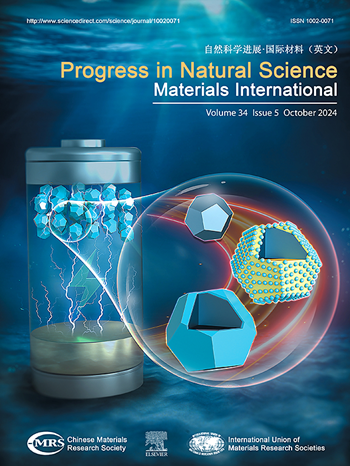The impact of solution time on the microstructure and properties of NiTip/6061 Al matrix composites fabricated by hot pressing and extrusion
IF 7.1
2区 材料科学
Q2 MATERIALS SCIENCE, MULTIDISCIPLINARY
Progress in Natural Science: Materials International
Pub Date : 2024-12-01
DOI:10.1016/j.pnsc.2024.11.005
引用次数: 0
Abstract
This study investigates the impact and underlying mechanisms of solution time on the microstructure and mechanical properties of NiTi particle-reinforced 6061 Al composites. The findings indicate that significant alterations occur in the interfacial reaction phase of the composites following treatment with varying solution times. As the solution time increases, the thickness of the interfacial reaction phase progressively increases. Furthermore, the interfacial reaction phase develops a double-layer structure, consisting of the AlTiSi phase that tightly surrounds the NiTi particles and the discontinuously distributed Al3Ni phase. The exceptional tensile strength and elongation characteristics of the 6061 Al alloy are attained following a 6-min solution treatment, after which these properties remain relatively stable. The NiTip/6061 Al composites demonstrate their peak tensile strength of 380 MPa and elongation of 17.1 % subsequent to a 30-min solution treatment; however, both tensile strength and elongation exhibit a decline thereafter. The fracture surface of the composite reveals prominent toughness dimples, with portions of the Al matrix adhering to the surfaces of the NiTi particles. This observation indicates a robust bonding relationship between the Al matrix and the NiTi particles, which can be attributed to the uniform distribution of the AlTiSi phase. Beyond a solution treatment duration of 30 min, the toughness dimples on the fracture surface diminish, and the Al matrix adhering to the NiTi particle surfaces gradually decreases due to the development of an increasingly uneven and coarse Al3Ni interface reaction phase as the solution time is extended.
固溶时间对热压挤压制备NiTip/6061 Al基复合材料组织和性能的影响
研究了固溶时间对NiTi颗粒增强6061 Al复合材料显微组织和力学性能的影响及其机理。研究结果表明,在不同的溶液时间处理后,复合材料的界面反应相发生了显著的变化。随着溶液时间的增加,界面反应相的厚度逐渐增大。界面反应相呈现双层结构,由紧密包裹NiTi颗粒的AlTiSi相和不连续分布的Al3Ni相组成。6061铝合金具有优异的抗拉强度和伸长率,经过6分钟固溶处理后,这些性能保持相对稳定。经30min固溶处理后,NiTip/6061 Al复合材料的抗拉强度达到380mpa,伸长率达到17.1%;然而,抗拉强度和伸长率均呈现下降趋势。复合材料的断口表面显示出明显的韧性韧窝,部分Al基体粘附在NiTi颗粒表面。这一观察结果表明,Al基体与NiTi颗粒之间存在牢固的结合关系,这可归因于AlTiSi相的均匀分布。固溶时间超过30 min后,随着固溶时间的延长,断口韧性韧窝减小,附着在NiTi颗粒表面的Al基体逐渐减少,这是由于Al3Ni界面反应相的发展越来越不均匀和粗糙。
本文章由计算机程序翻译,如有差异,请以英文原文为准。
求助全文
约1分钟内获得全文
求助全文
来源期刊
CiteScore
8.60
自引率
2.10%
发文量
2812
审稿时长
49 days
期刊介绍:
Progress in Natural Science: Materials International provides scientists and engineers throughout the world with a central vehicle for the exchange and dissemination of basic theoretical studies and applied research of advanced materials. The emphasis is placed on original research, both analytical and experimental, which is of permanent interest to engineers and scientists, covering all aspects of new materials and technologies, such as, energy and environmental materials; advanced structural materials; advanced transportation materials, functional and electronic materials; nano-scale and amorphous materials; health and biological materials; materials modeling and simulation; materials characterization; and so on. The latest research achievements and innovative papers in basic theoretical studies and applied research of material science will be carefully selected and promptly reported. Thus, the aim of this Journal is to serve the global materials science and technology community with the latest research findings.
As a service to readers, an international bibliography of recent publications in advanced materials is published bimonthly.

 求助内容:
求助内容: 应助结果提醒方式:
应助结果提醒方式:


